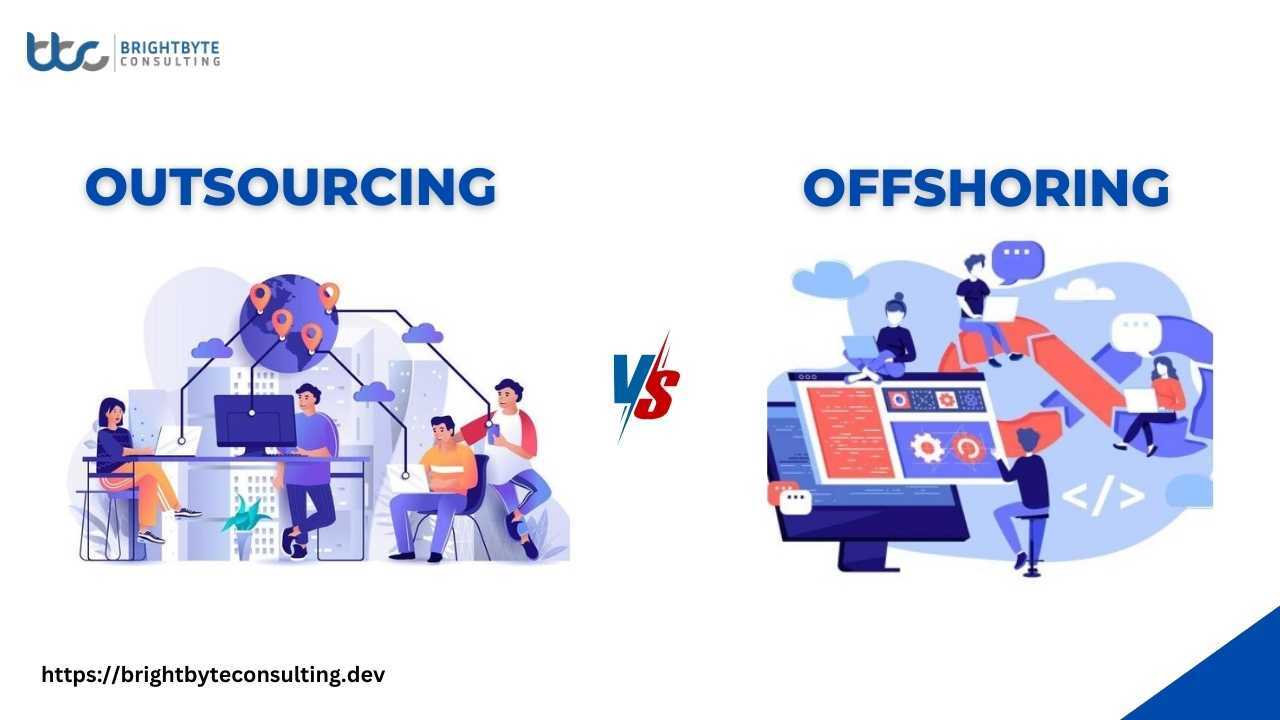The debate between in-house vs outsourcing remains a hot topic among entrepreneurs, especially when it comes to making the right choice for their projects. Are you grappling with this decision for your next venture? In-house vs outsourcing software development? It’s a million-dollar question for many businesses. Much like a coin has two sides, each approach comes with its own set of cutting edge solutions and drawbacks.
Ultimately, the goal of your business is to foster growth and scalability. The best approach depends on your specific needs and priorities. This article will help you make an informed decision about whether outsourcing or In House Development is the right choice for your needs.
What Is Outsourcing?
Outsourcing is the practice of delegating specific tasks or functions of a business to external companies or individuals, rather than handling them internally. This strategy is often employed to reduce costs, access specialized expertise, improve efficiency, and focus on core business activities.
Companies can outsource a wide range of functions, including IT services, customer support, manufacturing, marketing, and more. By leveraging the skills and resources of external contractors, businesses aim to achieve better outcomes while optimizing their internal resources.
What Is In-House Development?
Inhouse refers to the practice of conducting business activities or tasks within the organization using its own employees and resources, rather than outsourcing them to external parties. This approach involves hiring dedicated staff to perform specific functions, maintaining control over the processes, and ensuring alignment with the company’s vision and goals.
In-house operations are often chosen for tasks that require deep knowledge of the company, confidentiality, and direct oversight. Examples include in-house software development, marketing, customer service, and human resources management.
In House vs Outsourcing
The given table explains the difference between In House vs Outsourcing:
| Aspects | In-house | Outsourcing |
| Outsourcing vs inhouse cost | In House Staffing Costs is Higher (salaries, benefits, overhead) | Lower (flexible pricing, no benefits) |
| Control | Full control over processes | Limited control, managed by third party |
| Expertise | Requires hiring skilled professionals | Access to global talent and expertise |
| Flexibility | Less flexible, longer hiring process | Highly flexible, scalable as needed |
| Quality Assurance | Direct oversight ensures quality | Quality varies with provider’s standards |
| Focus on Core Business | May distract from core activities | Allows focus on core competencies |
| Communication | Easier, face-to-face interactions | Potential challenges due to time zones |
| Confidentiality | Higher, within company premises | Risk of data breaches, requires NDAs |
| Time to Market | Potentially slower due to internal processes | Often faster due to provider expertise |
| Innovation | Driven by internal culture | Fresh perspectives from diverse experts |
In House vs Outsourcing Pros & Cons
Both In House vs External teams have unique advantages & disadvantages that can significantly impact your business. Let’s have a look at them:
Advantages of Outsourcing
Cost Savings
Outsourcing typically leads to reduced expenses on salaries, benefits, and overhead. Companies can avoid the costs associated with hiring full-time employees by contracting with external service providers who often operate in lower-cost regions or economies of scale, thereby achieving significant savings.
Access to Expertise
Outsourcing allows businesses to tap into specialized skills and global talent pools that may not be available internally. This access to expertise enables companies to benefit from advanced knowledge, experience, and technologies that enhance the quality and efficiency of their projects.
Scalability
One of the key advantages of outsourcing is the ability to easily adjust the size of the team or resources allocated to a project based on current needs. This scalability ensures that businesses can ramp up or down quickly in response to fluctuations in workload or project requirements without the burden of hiring or downsizing internally.
Focus on Core Activities
By outsourcing non-core activities such as IT support, customer service, or back-office operations, organizations can free up internal resources and management bandwidth. This allows them to concentrate more effectively on core business functions that directly contribute to revenue generation and strategic growth.
Faster Time to Market
Outsourcing can accelerate project timelines by providing quick access to experienced teams and specialized resources. External providers often have established processes and methodologies that streamline project execution, reducing time-to-market for products or services.
Flexibility
Outsourcing offers flexibility to adapt quickly to changing business or project requirements. External providers can adjust their services, team composition, or delivery schedules to meet evolving needs, providing agility that may be challenging to achieve with an entirely internal workforce.
Risk Management
Collaborating with outsourcing providers allows companies to share and mitigate risks associated with operations, technology investments, regulatory compliance, and market fluctuations. Outsourcing contracts often include service-level agreements (SLAs) and risk-sharing mechanisms that provide financial protection and assurance of service quality.
Innovation
Outsourcing can bring fresh perspectives and innovative solutions from external experts who have diverse industry experience and a broader market outlook. This external input fosters creativity, drives continuous improvement, and helps companies stay competitive by adopting cutting-edge technologies and best practices.
Disadvantages of Outsourcing
Communication Challenges
Outsourcing often involves working with teams in different time zones and regions, which can lead to communication delays and misunderstandings. Language barriers may also affect the clarity and effectiveness of communication, impacting project coordination and productivity.
Quality Control
With less direct oversight, there is a risk of inconsistencies in the quality of work delivered by external providers. Different standards, practices, or interpretations of requirements may result in variations in output that do not meet internal expectations or customer standards.
Security Risks
Sharing sensitive data and information with external parties increases the potential for security breaches and data leaks. Lack of stringent data protection measures or inadequate cybersecurity protocols from outsourcing partners can expose businesses to significant security vulnerabilities.
Loss of Control
Outsourcing can reduce the level of control over project management, processes, and decision-making. This loss of control may hinder the ability to quickly address issues, make adjustments, or align with strategic priorities as closely as when activities are managed internally.
Dependency
Over-reliance on external providers for critical functions or specialized skills can create dependency issues. This dependency may limit flexibility in scaling operations, adapting to changing market conditions, or renegotiating terms of service, potentially impacting business continuity.
Cultural Differences
Variations in work culture, values, and business practices between the outsourcing company and external providers can lead to misunderstandings, conflicts, and challenges in collaboration. Differences in communication styles, decision-making processes, and work ethics may affect teamwork and project outcomes.
Hidden Costs
Outsourcing agreements may include hidden costs not initially accounted for in the contract, such as additional fees for changes in scope, unforeseen expenses in managing the relationship, or unexpected costs related to compliance, training, or transition.
Intellectual Property Risks
Outsourcing involves sharing proprietary information, intellectual property (IP), and trade secrets with external parties. The risk of unauthorized use, theft, or infringement of IP rights by outsourcing providers poses significant legal and reputational risks if proper safeguards and contractual protections are not in place.
In House Advantages
Better Control
Having an in-house team allows for more direct oversight and management. This enables better alignment with company goals, quicker decision-making, and more immediate adjustments to workflows and processes. Direct control can improve efficiency and quality of work.
Improved Communication
In-house teams benefit from direct, face-to-face communication, which can enhance collaboration and reduce misunderstandings. Proximity facilitates quicker resolution of issues and fosters a stronger team dynamic. This can lead to more cohesive and integrated work efforts.
Deep Company Knowledge
Employees working in-house develop a deep understanding of the company’s culture, products, and processes. This institutional knowledge can lead to more effective problem-solving and innovation. Familiarity with internal systems and priorities can also enhance productivity and consistency.
Greater Commitment
In-house employees often show greater commitment and loyalty to the company. This can result in higher levels of dedication, motivation, and accountability. The sense of belonging and job security can encourage employees to go above and beyond in their roles.
Customization and Flexibility
An in-house team can quickly adapt to changing company needs and priorities. Custom solutions can be developed that align closely with the company’s specific requirements. This flexibility allows for tailored approaches that can be more effective than generic, outsourced solutions.
Confidentiality
Sensitive information and intellectual property are better protected with an in-house team. There is less risk of data breaches or leaks compared to outsourcing. This security is crucial for maintaining competitive advantage and complying with privacy regulations.
In House Disadvantages
Higher Costs
Maintaining an in-house team involves significant expenses, including salaries, benefits, office space, and equipment. These costs can add up quickly, making it more expensive than outsourcing. Additionally, companies must account for overhead costs like utilities and maintenance.
Limited Expertise
In-house teams may lack specialized skills or experience for certain projects. This can limit a company’s ability to innovate or tackle complex tasks effectively. Hiring experts for every niche skill can be impractical and costly.
Resource Allocation
Fixed resources can lead to underutilization or overburdening of staff. Employees may sometimes have too little work, wasting company resources, or too much work, leading to burnout. Balancing workloads efficiently becomes a constant challenge.
Longer Hiring Process
Recruiting and training new employees is a time-consuming and costly process. It can take weeks or months to find the right candidates and bring them up to speed. This delay can slow down project timelines and reduce overall productivity.
Scalability Challenges
Scaling an in-house team quickly to meet project needs can be difficult. Hiring additional staff or downsizing during off-peak times is not always feasible. This lack of flexibility can hinder a company’s ability to respond to changing demands.
Maintenance Overhead
Managing employees requires ongoing effort and resources. Companies must invest in continuous development, employee management, and retention strategies. These efforts can be time-consuming and divert focus from core business activities.
Risk of Turnover
Staff turnover can disrupt operations and lead to knowledge loss. Replacing employees involves additional recruitment and training costs. Absenteeism can also affect project timelines and team productivity, creating further instability.
Which One Is Better?
Choosing between in house vs outsourcing depends on factors like control, expertise, and cost. In-house teams offer direct oversight, knowledge retention, and seamless collaboration but may incur higher operational costs. Outsourcing can reduce expenses, provide access to specialized skills, and scale resources as needed, but may pose challenges in quality control and communication. Ultimately, the best choice depends on the specific needs, resources, and strategic priorities of each organization.
BBC The Best Staff augmentation & Consulting Firm
BBC, recognized as a premier firm specializing in staff augmentation and consulting services, distinguishes itself through its commitment to excellence and client satisfaction. With a strong reputation for delivering tailored staffing solutions and strategic advice across diverse industries, BBC ensures optimal performance and efficiency. Trusted by businesses for its skilled professionals and personalized approach, BBC continues to be a preferred partner for organizations seeking top-tier staffing augmentation and consulting expertise.
Conclusion
Deciding between in house vs outsourcing depends on your business’s specific needs, budget, and long-term goals. In-house development offers greater control, quality assurance, and security but comes with higher costs and potential scalability challenges. Outsourcing, on the other hand, provides cost savings, access to specialized skills, and flexibility, yet may pose communication and control issues. By carefully weighing the pros and cons of each approach, you can make an informed decision that best supports your business objectives and growth strategy.
FAQs
What is in-house development?
In-house development refers to conducting business activities using internal employees and resources within the organization, rather than outsourcing them to external parties.
What are the advantages of in-house development?
In-house development offers greater control over processes, enhanced communication, direct oversight of quality, and alignment with company culture and goals.
What are the disadvantages of in-house development?
Disadvantages include higher costs for salaries, benefits, and infrastructure, potential limitations in expertise, longer hiring processes, and challenges in scaling teams as needed.
What is outsourcing?
Outsourcing involves delegating specific tasks or functions of a business to external companies or individuals, typically to reduce costs, access specialized expertise, and focus internal resources on core activities.
What are the advantages of outsourcing?
Outsourcing provides cost savings, access to global talent and specialized skills, scalability to adjust team size as needed, faster time-to-market, and opportunities for innovation through external perspectives.
What are the disadvantages of outsourcing?
Disadvantages include communication challenges due to time zones and language barriers, potential risks to data security and intellectual property, reduced control over project management, and dependency on external providers.
How should businesses decide between in house vs outsourcing?
Businesses should consider factors such as project requirements, budget constraints, desired level of control, need for specialized expertise, and long-term scalability goals to determine whether in-house development or outsourcing is the best fit for their needs.











